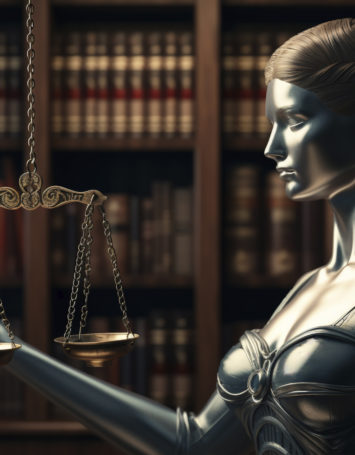Article by Sarah Benowich
Luxury French fashion house Hermès may continue its lawsuit against a digital artist “Mason Rothschild” for his creation of nonfungible tokens (NFTs) depicting faux fur covered Birkin bags, according to a recent decision by Judge Rakoff of the Southern District of New York.[1] In denying Rothschild’s motion to dismiss, Judge Rakoff has left for future proceedings the complex and fact-intensive questions of whether these NFTs are sufficiently expressive and not misleading to shield them from being considered infringing. This decision has significant lessons and practical implications as brands and creators navigate traditional IP principles applied to new digital frontiers.
- Background
- The Parties
Hermès is an iconic French luxury brand “known for, among other products, its unique Birkin handbag, which sells for anywhere from thousands of dollars to over one hundred thousand dollars.”[2] Hermès owns trademark rights in the HERMES and BIRKIN marks, and trade dress rights in the Birkin handbag design.[3] Hermès first introduced its Birkin bag, named for British actress Jane Birkin, in 1984. Since then, it has been an elusive and exclusive symbol of luxury and quality, as people try – even clambering to join waiting lists and befriend sales associates who are themselves in the dark as to the availability of the bags – for years for the chance to purchase one of the limited number of handmade bags. Birkin bags have even been considered better investments than stocks or gold.[4]
Rothschild, who had 16.5k Instagram followers at the time of the decision and now has nearly 20k followers, calls himself a “Digital creator” and “web3cowboy”. Just a few months before selling the NFTs giving rise to this dispute, Rothschild created a digital image entitled “Baby Birkin,” which depicted a 40-week-old fetus gestating inside of a transparent Birkin handbag. “Rothschild sold the NFT linked to the ‘Baby Birkin’ digital image for $23,500; it later resold for $47,000.”[5]
The NFTs at the heart of this case are 100 digital images of “faux-fur-covered versions” of the classic Birkin bag[6]:
Rothschild initially described the NFTs, which he calls “MetaBirkins”, as in the Metaverse, as “a tribute to Herm[e]s’ most famous handbag, the Birkin, one of ‘the most exclusive, well-made luxury accessories. Its mysterious waitlist, intimidating price tags, and extreme scarcity have made it a highly covetable ‘holy grail’ handbag that doubles as an investment or store of value.’”[7] Rothschild’s initial compliments only underscored Hermès’ impression that he was attempting to trade on their iconic status, and at least three media outlets mistakenly believe that the “NFTs were unveiled by Hermès in partnership with Rothschild.”[8]
NFTs, or “non-fungible tokens,” are “units of data stored on a blockchain that are created to transfer ownership of either physical things or digital media.”[9] “When NFTs are created, or ‘minted,’ they are listed on an NFT marketplace where NFTs can be sold, traded, etc., in accordance with [self-executing] ‘smart contracts’ that govern the transfers.”[10] Since “NFTs can be easily sold and resold with a transaction history securely stored on the blockchain, [they] can function as investments that can store value and increase value over time.”[11]
NFT transactions take place on blockchains, which are distributed databases shared on a computer network and store information digitally. Unlike a typical traditional database, which can be altered, a blockchain cannot be, making it an immutable record such that, for example, once a transaction is entered it cannot be reversed. The same principle follows for entry of ownership of an image: once the owner of an image is entered, it cannot be erased or changed, and because it is decentralized – i.e., no single person or group has control – anybody can access the information.
This type of technology is being used and touted for protecting owners and creators’ intellectual property and ownership rights and as a method for ensuring that original creators retain credit and get some portion of profits from subsequent sales. However, as this case highlights, NFTs can also be a new environment that brands and creators need to monitor to protect their IP.
- The Procedural Posture
Before filing this lawsuit, Hermès sent a cease-and-desist letter to Rothschild and OpenSea, the largest NFT marketplace which was also selling some of the MetaBirkins NFTs. OpenSea complied with the cease-and-desist by taking down the NFT listings. As would be standard, Hermès attached to its letters a long list of its trademarks, including its trade dress for the handbag design of the Birkin, which is generally available in one standard design in different sizes, colors, hardware fixtures, and materials. Notably, while the mark HERMES covers almost every class of goods, it does not cover any digital goods.
Rothschild responded to the cease-and-desist differently: selling the NFTs on another platform and on <MetaBirkins.com> with the disclaimer: “We are not affiliated, associated, authorized, endorsed by, or in any way officially connected with HERMES, or any of its subsidiaries or its affiliates. The official HERMES website can be found at www.Hermes.com.”
Rothschild also posted the following message on his MetaBirkins-dedicated Instagram account:
This letter is the first glimpse into what would become Rothschild’s defense strategy of claiming artistic expression and freedom of speech as a shield. The ultimate question may very well be whether Rothschild’s digital images are just the modern analogue to Andy Warhol’s iconic Campbell’s soup series. This message also hints that Rothschild may have offered to formalize some type of partnership or relationship with Hermès, which may, generally speaking, offer brands an opportunity to enter this arena with digital creators who may be more adept at navigating this content and giving brands more leverage and control over the images.
Hermès ultimately sued Rothschild in January, alleging that his MetaBirkins NFTs infringe their trademarks.
- The District Court’s Decision
The main dispute centered on which test would apply to the NFTs: Rogers v. Grimaldi, 875 F.2d 994 (2d Cir. 1989) (shielding from infringement liability those works that are both (1) an artistic expression and (2) do not explicitly mislead consumers) or the more classical infringement analysis represented in Gruner + Jahr USA Pub. v. Meredith Corp., 991 F.2d 1072, 1074 (2d Cir. 1993) (assessing the Polaroid factors). Judge Rakoff held that although Rogers applied, there were still considerable questions of fact as to “explicit misleadingness either as a function of likelihood of confusion under the Polaroid factors” to defeat Rothschild’s motion to dismiss.[12]
In particular, the Court looked to Hermès’ allegations that Rothschild “intended to associate the ‘MetaBirkins’ mark with the popularity and goodwill of Hermès’ Birkin mark”, which were supported by Rothschild’s own public statements, including:
for me, there’s nothing more iconic than the Herm[e]s Birkin bag. And I wanted to see as an experiment if I could create that same kind of illusion that it has in real life as a digital commodity,
the difference between owning the bag and an NFT was ‘getting a little bit blurred now because we have this new outlet, which is the metaverse, to showcase, showcase them in our virtual worlds, and even just show them online.’[13]
Following Rothschild’s analogy, unlike Warhol, who did not aim – at least not explicitly – to trade on Campbell’s soup brand and actually elevated a quotidian product to pop art status, Rothschild, in his own words, was seemingly trying to ride Hermès’ coattails and “blur” the lines between his digital images of Birkin bags and actual Birkin bags.
Regardless, the Court noted that “even if the commercial aspects of a work are intertwined with artistic content, the trademark-using speech must be treated as noncommercial” and the court must balance “the First Amendment concerns with Lanham Act protection [which] requires applying the Rogers test.”[14] Similarly, the Court ruled, Rothschild’s use of Hermès’ BIRKIN mark functioned was both a source identifier and “inextricably intertwined” with its “communicative, artistic function” as a title of the NFTs.[15]
Further, while the “threshold for ‘artistic relevance’ is intended to be low”, Hermès sufficiently alleged “that Rothschild entirely intended to associate the ‘MetaBirkins’ mark with the popularity and goodwill of Hermès’s Birkin mark, rather than intending an artistic association.”[16] Ultimately determining the artistic qualities of the NFTs is sure to be a fact-intensive, difficult inquiry.
The Court looked to similar allegations and those going to the Polaroid factors when holding that Hermès sufficiently alleged that Rothschild’s NFTs were explicitly misleading, such that even if they were considered “art”, they may still be infringing works.
Hermès’ remaining trademark dilution and cybersquatting claims survived to “rise and fall with the First Amendment defense to the trademark infringement claims and the application of the Rogers test: that if Rogers protects Rothchild’s ‘MetaBirkins’ uses against trademark infringement claims, it even more clearly protects against trademark dilution and cybersquatting claims.”
Hermès seeks monetary damages, including disgorgement of Rothschild’s profits, and injunctive relief to bar Rothschild from further using its trademarks, such as by “using any reproduction, copy, counterfeit, or colorable imitation of Hermès’ federally registered trademarks to identify any goods or the rendering of any services not authorized by Hermès.”
- Practical Implications
While NFTs have been heralded as a new way to protect IP rights and compensate original owners, they clearly can also be another way to infringe and businesses, judges, and lawyers will have to become increasingly facile with these concepts.
- Even more traditional brands must be aware of digital spaces and strategize as to their entry or monitoring of those spaces.
- Brands looking to enter or engage with digital images should add NFT or digital images as a covered good, possibly through intent-to-use applications. Brands including Nike, Valentino, Versace, Yves Saint Laurent, Levi’s, Audemars Piguet, Burberry, Fenty, and Bulgari are increasingly looking to do so, and there have already been thousands of applications in 2022 alone for “NFT-related” trademarks, up from just several hundred during the same time last year.[17]
- If your brand is going to create or sell NFTs, make sure to draft contracts (or smart contracts) that specify terms like minting, royalty rights, and IP ownership.
- Rather than seeking to shut down creators, brands may want to think creatively and strategically about partnering with different creators. Of course, all the press garnered from the lawsuit may only serve to increase the value of the NFTs, and land the concept of the MetaBirkin in the mainstream.[18]
[1] See Hermès International, et al. v. Mason Rothschild, 1:22-cv-00384 (S.D.N.Y.), decision at 2022 U.S. Dist. LEXIS 89799, __ F. Supp. 3d __, 2022 WL 1564597.
[2] Id. at *2.
[3] See id.
[4] See Why The Hermès Birkin Bag is a Better Investment Than Gold, Time (Jan. 15, 2016) https://time.com/4182246/hermes-birkin-bag-investment-gold/ (last visited June 16, 2022).
[5] Id. at *4.
[6] Images taken from <MetaBirkins.com> as of June 14, 2022.
[7] Id. at *4-5.
[8] Id. at *6.
[9] Id. at *2 (quoting Am. Compl., ¶ 4).
[10] Id. (citing Am. Compl., ¶¶ 61, 63).
[11] Id. at *2-3 (citing Am. Compl., ¶ 69).
[12] Id. at *8.
[13] Id. at *5.
[14] Id. at *11.
[15] Id. at *11 (quoting Rogers, 875 F.2d at 998).
[16] Id. at *13 (internal citations omitted).
[17] See NFT, Metaverse-Focused Trademark Applications Continue to Climb in U.S., The Fashion Law (June 14, 2022), https://www.thefashionlaw.com/nft-metaverse-focused-trademark-applications-continue-to-climb-in-u-s/ (last visited June 14, 2022).
[18] See DeeHouseMF, MetaBirkin (“Mamma said she want land and a metabirkin
[….] She goin’ flex with her purse through the metaverse
This is not a jpeg
This picture perfect”)



